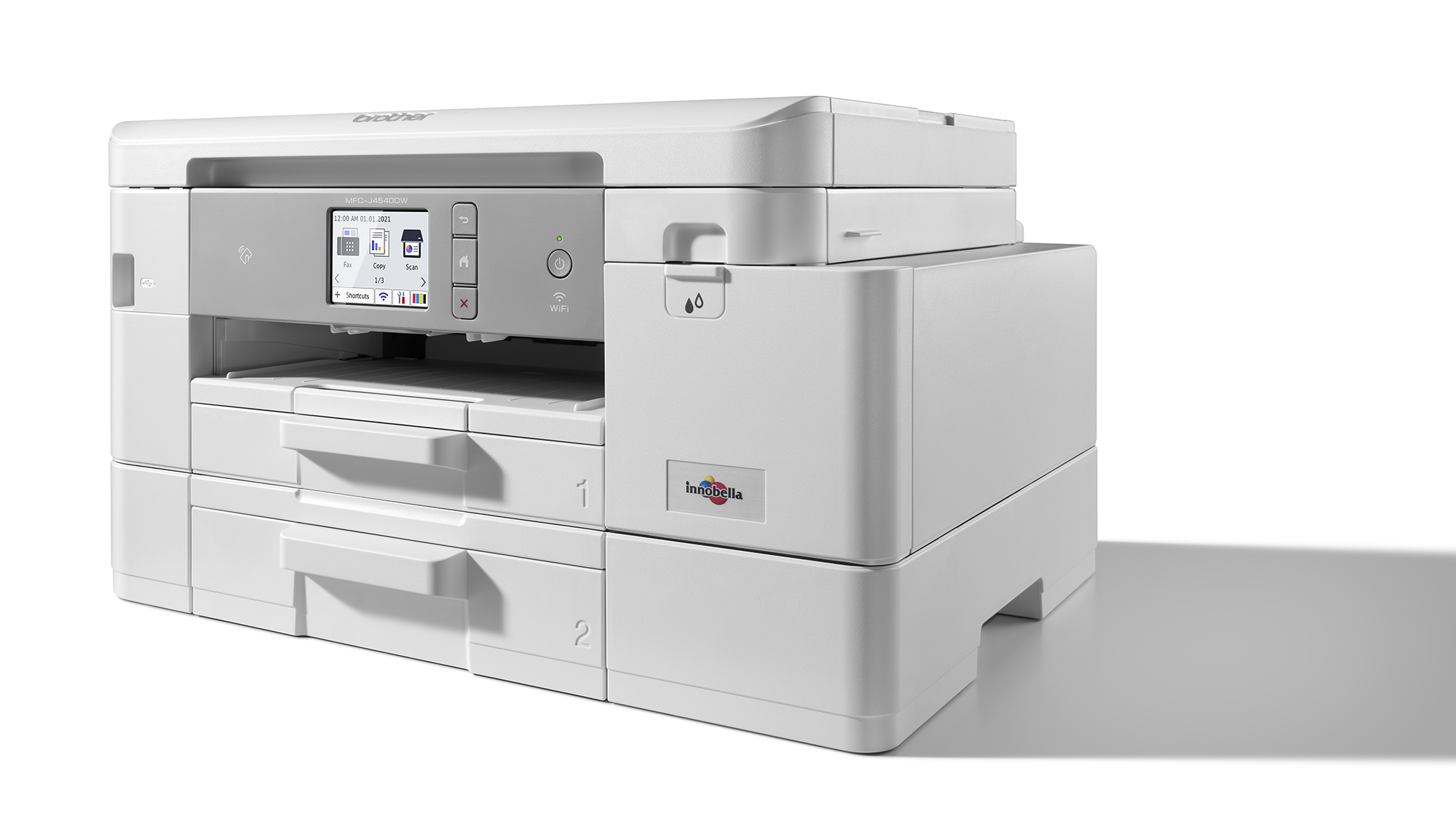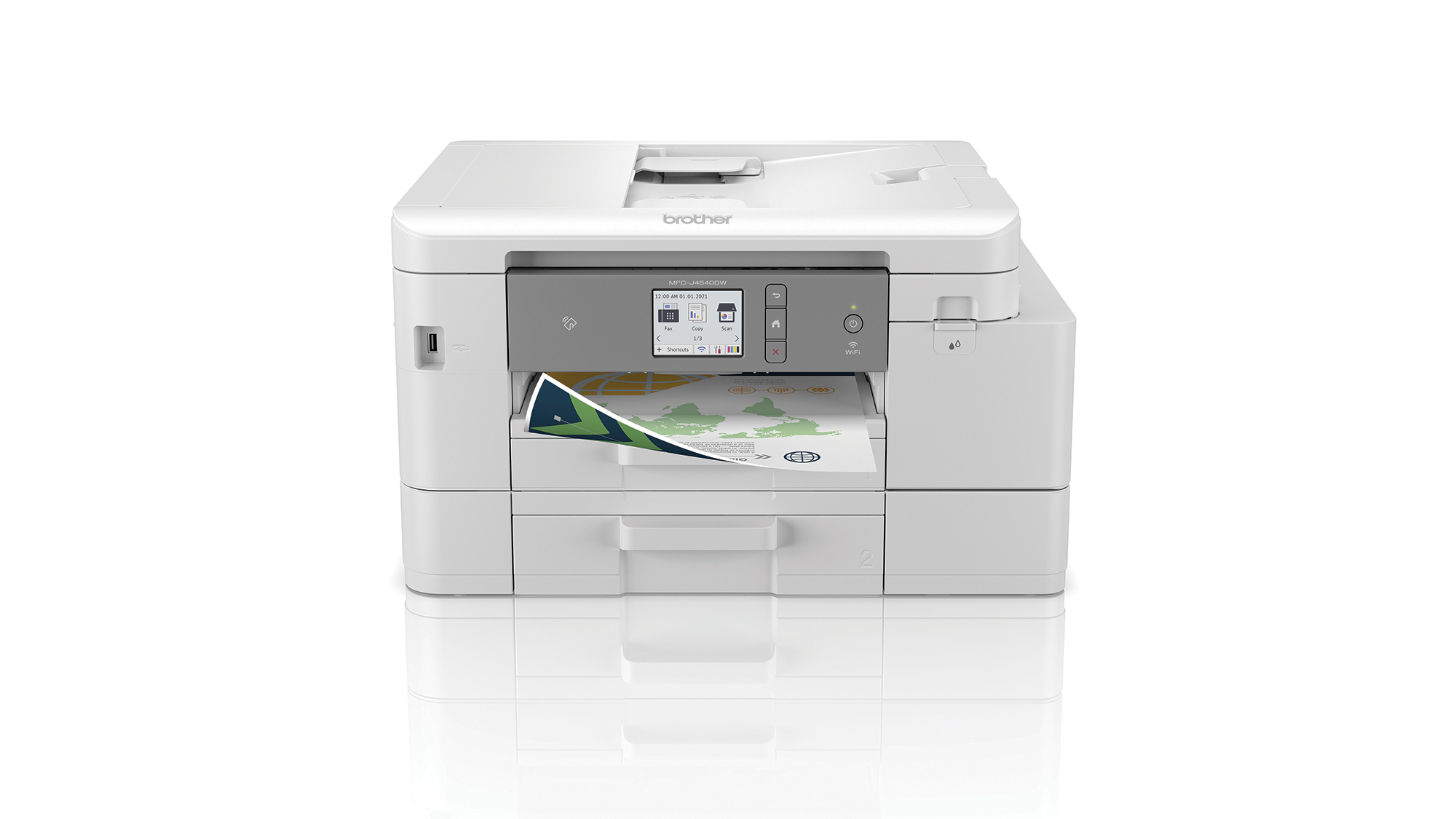Brother MFC-J4540DW review: Office-quality printing at home
An inkjet MFP for home-based staff that shows promise in a new category

-
+
Easy Setup
-
+
Remote Network Management
-
+
Supports Cloud Services
-
+
Low price per page possible
-
-
Washed out colours
-
-
High outlay for replacement ink
-
-
Not ideal as the only printer in your home
Brother would be the first to admit that its new range of printers, which includes the new MFC-J4540, is a product of the pandemic, designed to appeal to remote workers who want office quality printing in their own home. But is this luxurious 4-in-1 MFP the answer, or even a necessary upgrade? The answer to that isn’t exactly straight forward, but there’s a lot to like.
The unit itself is fairly compact for its functionality, fitting into a 43x35cm footprint on your desk. Its 25cm height allows room for a second paper tray, a relatively rare feature on SOHO printers. Its appearance betrays its hybrid nature, and it looks like a cross between a modest domestic MFP and a fuller, bulkier office device. The white finish guarantees it will never disappear into the background, but with its sleek angles and foldaway output trays, as well as the 6.8cm colour touchscreen display, it also looks smart wherever it ends up.
Although it can be attached directly to your computer via a USB 2.0 connection, additional connectivity is offered via wireless 802.11b/g/n connections or wired Ethernet cable. There’s even NFC capability, which lets you send a document from your mobile device to the printer with a single tap - though it currently only works with Android devices. As well as the copy and scan functions, it can also be used as a fax machine by attaching it to the phone line with an RJ45 cable.
Lexmark MC3326i review: A tempting proposition Best printers 2021: For all your printing, scanning and copying needs Kyocera Ecosys M6235cidn review: Worth splashing out on
Other features include a 20 sheet automatic document feeder and a 400 sheet total paper capacity, split across two paper trays which can take multiple paper sizes up to and including A4.
Setup proved to be largely hassle-free. The Brother Connect app allowed us to breeze through the process of installing the four cartridges and adding it to our Wi-Fi network with just a few clicks, once it had our username and password, and we were online and ready to print in around ten minutes from unboxing.
The app may feel a little underpowered for some; the print functions it offers are rather basic, but for the vast majority, this is as much as you need from mobile printing. There’s also a comprehensive maintenance section as well as the ability to check ink levels and if necessary, order more. The option to print remotely from another network is available too, but for security reasons, this has to be configured separately.

For more robust print management, the J4540DW uses Brother’s iPrint&Scan software suite for Windows. Rather confusingly, there is an app with the same name for mobile devices, but it’s not compatible with this range. The Windows version offers a few “nice to haves”, including workflows for automating tasks such as printing documents and publishing them to Sharepoint or even printing to all devices on a given domain. There are also integrations with Dropbox, Google Drive and OneDrive.
Perhaps the best way to control your printer is the display, which can be angled for easier viewing, and offers a clean, responsive touch interface to control all aspects of setup, everyday use and maintenance. These are bolstered by hardware buttons for power, home, back and cancel functions, plus the aforementioned NFC pad for direct connection to your mobile.
That mention of Sharepoint is a clue to one of this device’s secret weapons which allow it to bridge the gap between home and the office. As well as working autonomously, IT Admins are given everything they need to deploy this printer from a remote network or domain. It can even be deployed to a virtual desktop. Full details for SysAdmins are on the Brother support pages.
When it comes to actually printing, the 1200x2400 dpi resolution (both monochrome and colour) should produce sharp results, and it does, but sadly the colours feel washed out and faded, particularly in the blue/green part of the spectrum. We printed a photo taken on one of the sunniest days of 2021, and it looked almost autumnal.
We should note that Brother recommends its own “Innobella” brand for both printer and ink, warning (as most printer manufacturers do) that using anything else will degrade results. Brother didn’t supply any Innobella paper for this review, which could be the cause of our banding issues, but we can’t definitively confirm that using Brother’s special paper would fix it - nor should it be necessary to use a specific kind of paper, especially in a device made for home workers. On the other hand, both spot colour and monochrome prints fared better, with crisp, clean text, clear charts and defined tables.
Brother claims print speeds of up to 20 pages per minute. Our real world test, using a 20 page magazine, mixing text and graphics, was significantly slower, however, yielding 16ppm in black and white, but a mere 3.7 ppm in full colour. Even with plain black and white text, we couldn’t reproduce 20ppm - the fastest we could get was 16.
Scanning was incredibly impressive though, taking just 11 seconds for a full colour A4 scan at 1200x1200dpi. The results were clear, accurate and without any trace artifacts on the result.
This brings us onto running costs, and a set of standard capacity cartridges is included with the printer. The black cartridge is capable of up to 3,000 pages and, retailing at £21.99 (exc VAT), it makes monochrome printing a very reasonable 0.7p per page. Add in the three color cartridges (Magenta, Cyan and Yellow) with a 1,500 page capacity at £16.99 (exc VAT) and that brings the cost of a colour print to 3.3p per page.
However, if you’re willing to accept the initial outlay, you can bring those prices down significantly with XL cartridges. An XL black cartridge with a 6,000-page yield costs £39.99 (exc VAT), and while the cost per page is unchanged from the standard capacity, adding the three colour XL cartridges, priced at £43.79 each for a 5,000 page yield, works out at a significantly more reasonable 2.6p for a colour print. Even after adding back the VAT, you’re left with a much cheaper offering, both compared to standard cartridges and indeed most other inkjet printers.
There’s little doubt that this is a powerful workhorse, but it does come with some serious caveats. The large initial outlay compared to a domestic MFP, and emphasis on fast monochrome prints over quality photo reproduction suggests that this is an MFP designed for deployment by companies for their home workers. The main downside to this is that if it doesn’t meet all your needs for home and work, you’re likely to end up with not one but two MFPs in your home office, and that takes up a significant amount of desk space.
Alternatively, if you’re buying it for yourself, the initial outlay for new cartridges is on the high side compared to, for example HP’s Instant Ink scheme, and although the resulting cost per page is attractive, there are better ways of self-financing your printing needs from better all-rounder MFPs for both work and play. In what is almost a new category of MFP, this is a promising start, but it’s definitely at its best when supplied by companies to remote workers, rather than one for SOHO purchasers.
Brother MFC-J4540DW specifications
| Format | A4 inkjet MFP |
| Print speed | Up to 20ppmOur test: 16ppm (B&W) 3ppm (Color) |
| RAM | 128MB RAM |
| Display | 6.8cm colour touchscreen |
| Networking | Gigabit Ethernet, 802.11n wireless, RJ45 (fax), Mobile, Remote Domain |
| Connectivity | 1 x USB 2 |
| Print type | Duplex |
| Tray size | 2x200 sheet pages up to A4 |
| Dimensions | 411 x 394 x 344mm |
| Weight | 10.4 kg |
| Warranty | 3 yr RTB with registration |
Get the ITPro daily newsletter
Sign up today and you will receive a free copy of our Future Focus 2025 report - the leading guidance on AI, cybersecurity and other IT challenges as per 700+ senior executives
Chris Merriman has been writing about technology since the 1990s for a variety of titles including Computer Shopper, MSN, TechRadar, Tom’s Guide and The Inquirer, where he broke a number of major tech news stories that were picked up globally. He has appeared on BBC, Sky News and Al Jazeera and was the resident tech expert at TalkRadio for a number of years. In between times, he has also been a consultant for several major tech firms.
Chris is fascinated by automation and the internet of things, as well as the evolution of the ways we communicate in the digital era. He's also a frequent contributor to ITPro's software guides, including Windows operating systems. Other specialisms include storage, peripherals, and web apps, and any gadget he’s allowed to take apart and fiddle with, preferably after throwing away the box, manual and receipt.
-
 ‘Phishing kits are a force multiplier': Cheap cyber crime kits can be bought on the dark web for less than $25 – and experts warn it’s lowering the barrier of entry for amateur hackers
‘Phishing kits are a force multiplier': Cheap cyber crime kits can be bought on the dark web for less than $25 – and experts warn it’s lowering the barrier of entry for amateur hackersNews Research from NordVPN shows phishing kits are now widely available on the dark web and via messaging apps like Telegram, and are often selling for less than $25.
By Emma Woollacott Published
-
 Redis unveils new tools for developers working on AI applications
Redis unveils new tools for developers working on AI applicationsNews Redis has announced new tools aimed at making it easier for AI developers to build applications and optimize large language model (LLM) outputs.
By Ross Kelly Published
-
 Google layoffs continue with "hundreds" cut from Chrome, Android, and Pixel teams
Google layoffs continue with "hundreds" cut from Chrome, Android, and Pixel teamsNews The tech giant's efficiency drive enters a third year with devices teams the latest target
By Bobby Hellard Published